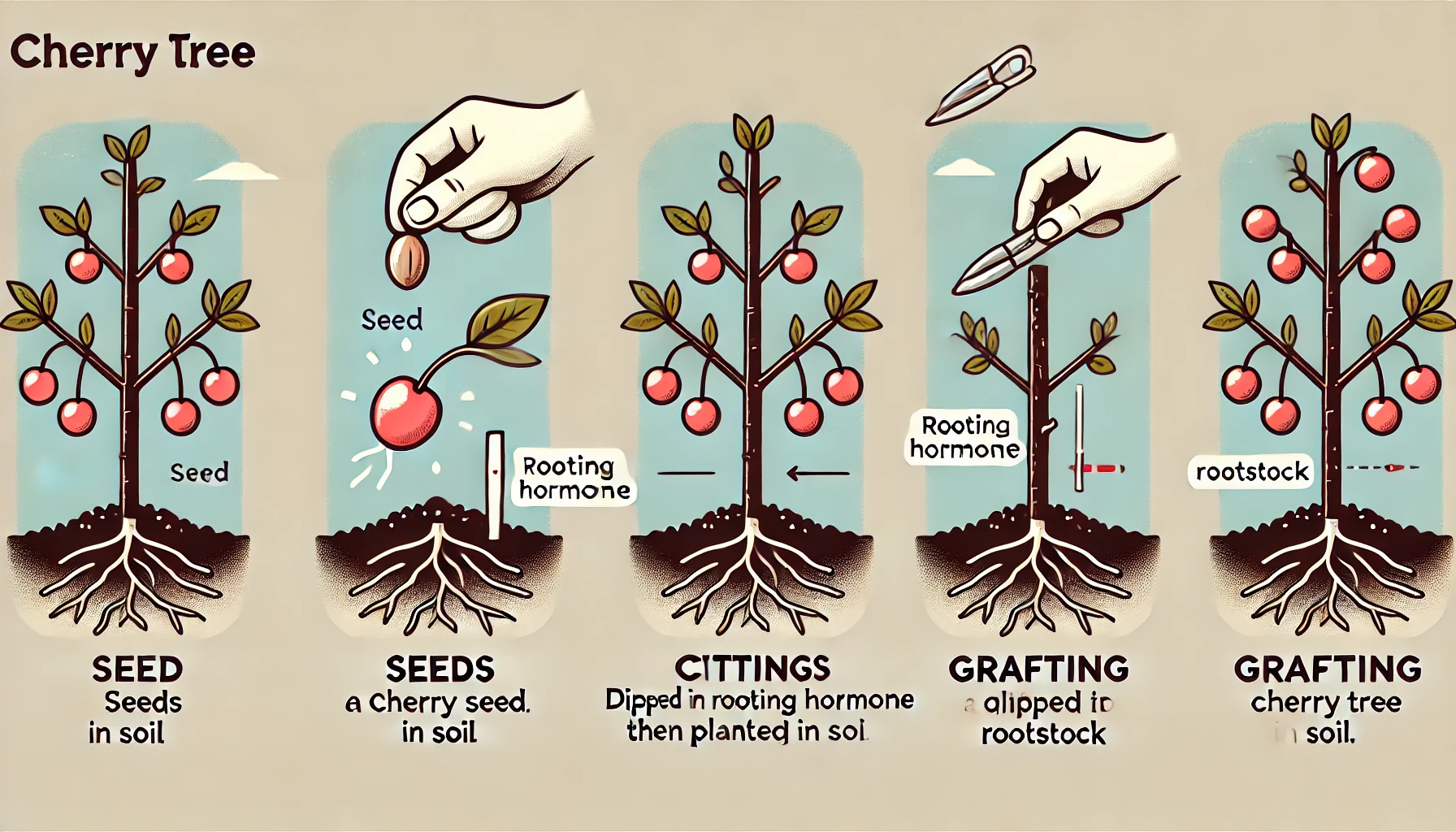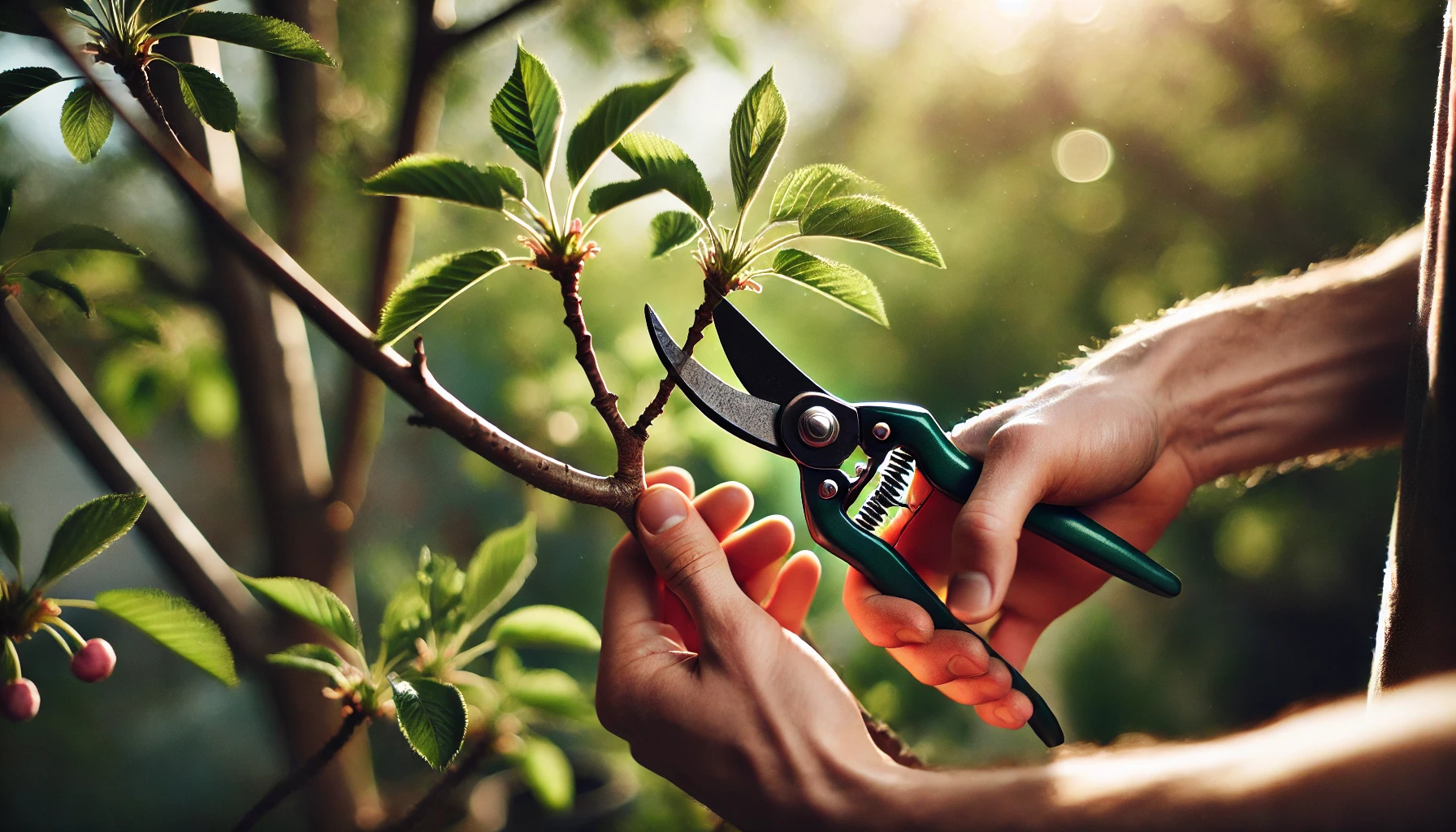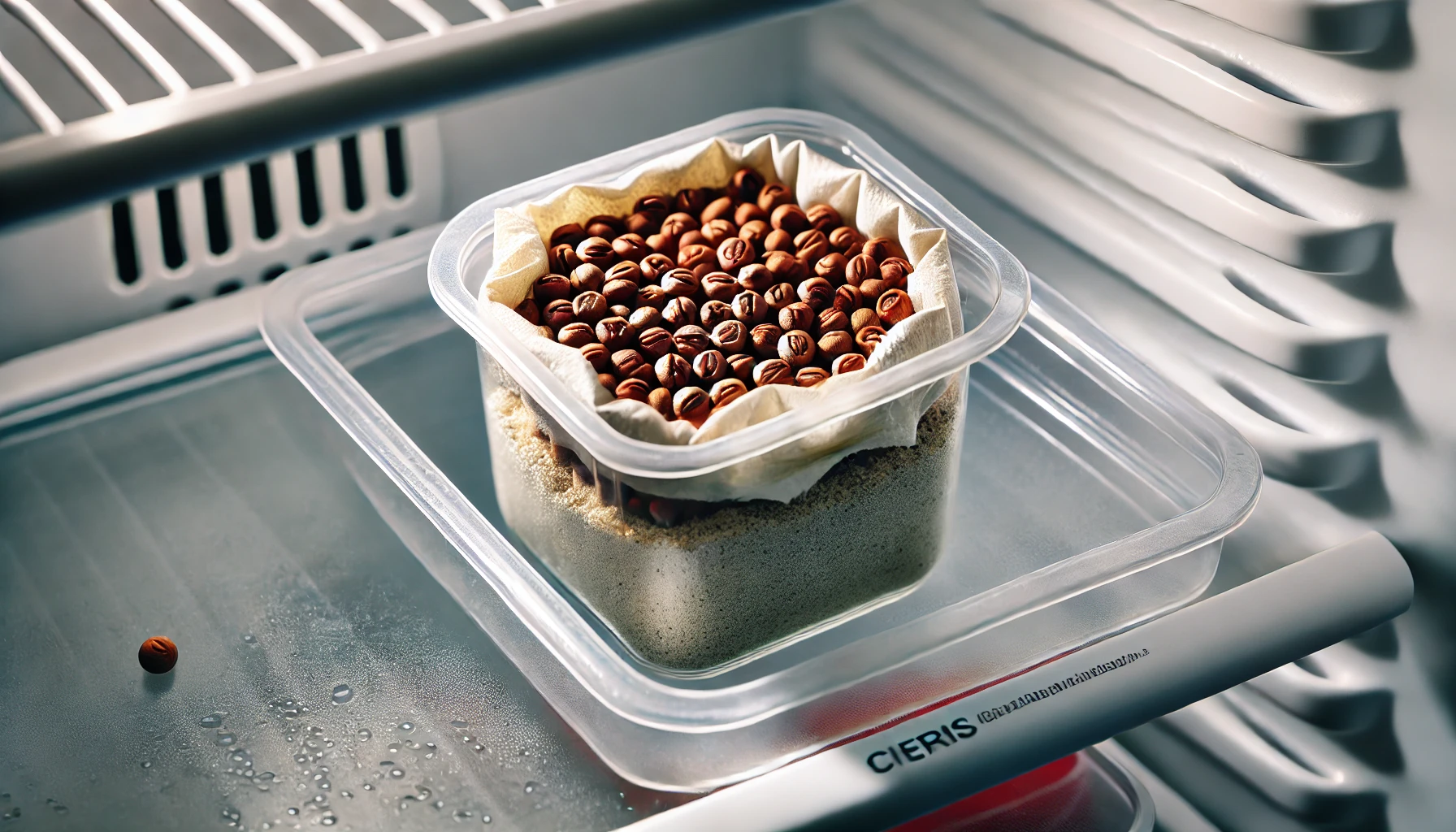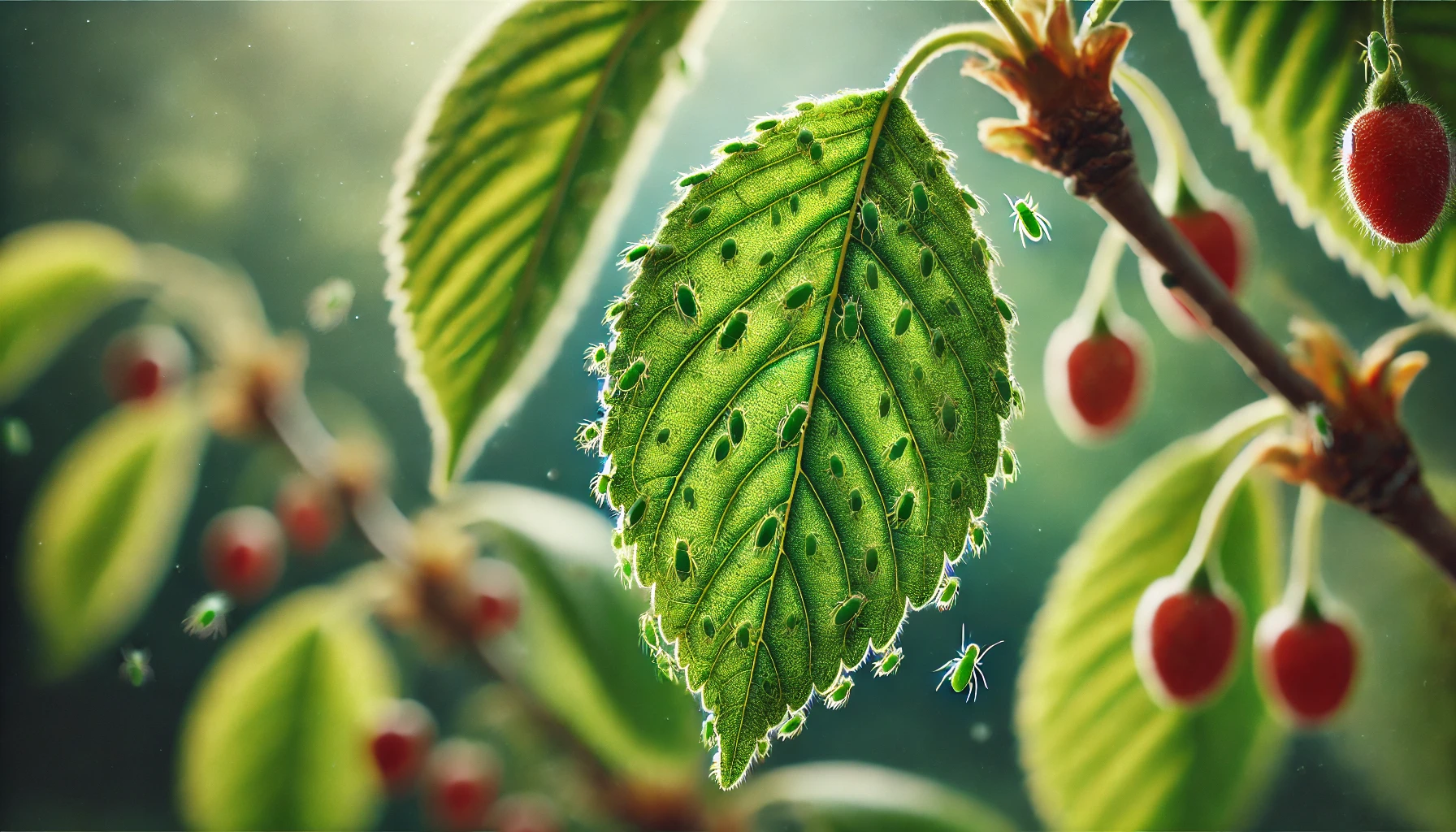
How to Propagate Cherry Trees from Cuttings and Seeds: A Step-by-Step Guide
Imagine growing a cherry tree from scratch—whether it’s from a cutting or seed, it’s an incredibly rewarding experience. If you’ve ever wondered how to propagate cherry trees from cuttings and seeds, you’re in the right place! Propagating your own trees allows you to preserve the genetic traits of your favorite cherry varieties and enjoy fresh fruit for years to come. In this step-by-step guide, we’ll walk you through the best techniques to successfully propagate cherry trees, whether you’re working with cuttings or seeds, and help you grow your very own cherry orchard at home. Let’s dive in!
Table of Contents
ToggleUnderstanding Cherry Tree Propagation 

Cherry tree propagation is a fantastic way to grow your own fruit-bearing trees. It involves creating new cherry trees from an existing one, and there are several methods to achieve this. Whether you’re looking to expand your orchard or simply want to grow a tree in your backyard, understanding the right propagation techniques is key.
1. Methods of Propagation
There are three main methods to propagate cherry trees: seeds, cuttings, and grafting.
- Seeds: While growing cherry trees from seeds is possible, it’s a slower method. Seedlings may take several years to fruit, and the tree might not be identical to the parent. However, it’s a rewarding and cost-effective way to start!
- Cuttings: This method involves taking a small branch from a healthy cherry tree and encouraging it to root in soil or water. This is faster than seed propagation, and the new tree will be genetically identical to the parent.
- Grafting: This is the most reliable way to propagate cherry trees. It involves attaching a young cherry tree branch (scion) to a strong rootstock. Grafting guarantees the new tree will grow the same type of fruit as the parent tree.

2. Best Time for Propagation 
Timing is essential when propagating cherry trees. The best time for grafting and taking cuttings is during the late winter or early spring, while the tree is still dormant. For seeds, late fall is ideal, as it allows the seeds to undergo natural cold stratification.
3. Choosing the Right Cherry Tree Varieties 
Not all cherry tree varieties propagate well from seeds or cuttings. Choose a variety known for good rootstock compatibility or ease of rooting when using cuttings. Sweet cherries are often harder to propagate than sour cherries, which are more adaptable.
By understanding the various propagation methods and the best times to start, you can successfully grow healthy cherry trees that will bear delicious fruit for years to come!
Propagating Cherry Trees from Cuttings 
Propagating cherry trees from cuttings is a cost-effective and rewarding way to grow new trees. Here’s how you can do it successfully:
- Choose the Right Cutting
Select a healthy, disease-free cherry tree with strong growth. Take a 6-8 inch (15-20 cm) cutting from a softwood or semi-hardwood branch. Ensure the cutting has at least 2-3 leaf nodes. - Prepare the Cutting
Remove the leaves from the bottom half of the cutting. Trim the top to just above a leaf node. This promotes healthy root development.
- Use Rooting Hormone
Dip the cut end of the cherry tree cutting in rooting hormone powder. This helps stimulate root growth and increases your chances of success. - Plant the Cutting
Plant the cutting in a small pot filled with well-draining soil. Water the soil lightly and make a small hole in the center. Insert the cutting about 2-3 inches deep, ensuring the leaf nodes are below the surface. - Create a Humid Environment
Cover the cutting with a plastic bag or clear plastic container to maintain humidity. Place the pot in a bright, indirect light location, keeping it warm but not in direct sunlight. - Keep the Soil Moist, Not Wet
Water the cutting when the top layer of soil feels dry. Avoid overwatering, as this can cause the cutting to rot. - Check for Roots
After 4-6 weeks, gently tug on the cutting. If you feel resistance, it means roots have started to form. At this point, you can transplant the cutting into a larger pot or directly into your garden.
By following these steps, you’ll give your cherry tree cutting the best chance to root and grow into a healthy, thriving tree!
Propagating Cherry Trees from Seeds 
Propagating cherry trees from seeds is a rewarding process, but it requires patience and care. Here’s a simple, step-by-step guide to help you get started:
1. Collecting Cherry Seeds 
Begin by selecting ripe cherries from a healthy tree. Remove the seeds by carefully washing and drying them. Make sure to pick cherries that are free from diseases and pests.
2. Stratifying the Seeds 
Cherry seeds require a period of cold treatment (stratification) to break dormancy. Place the seeds in a damp paper towel or sand and store them in the refrigerator for about 10–12 weeks. This cold period mimics winter conditions and prepares the seeds for germination.
3. Preparing the Soil 
Once stratification is complete, it’s time to plant your seeds. Choose well-draining, nutrient-rich soil. Cherry trees prefer slightly acidic to neutral soil, so ensure the pH is between 6.0 and 7.0.
4. Planting the Seeds 
Plant the seeds about 1–2 inches deep into the soil. If planting in pots, ensure they have drainage holes to prevent waterlogging. Gently water the seeds after planting and keep the soil moist, but not soggy.
5. Germination and Care 
Place the pots or seeds in a warm, sunny spot, as cherry seeds need plenty of light to germinate. Expect germination to take anywhere from 2–6 weeks. Once seedlings sprout, continue providing them with ample sunlight and keep the soil moist, but be careful not to overwater.

6. Transplanting Your Seedlings 
When the seedlings have grown large enough to handle and have several sets of leaves, transplant them to a larger pot or directly into your garden. Make sure to space them properly to allow for growth.
Tips for Success:
- Patience is key: It may take a few years before your tree begins to produce fruit.
- Temperature matters: Cherry trees thrive in cooler climates, so if you live in a warmer area, consider growing them in pots so you can move them around.
- Protection from pests: Keep an eye out for insects and diseases, especially in the early stages of growth.
With these simple steps, you’ll be well on your way to growing your own cherry tree from seed!

 Common Challenges in Cherry Tree Propagation
Common Challenges in Cherry Tree Propagation 

While propagating cherry trees can be rewarding, it does come with its challenges. Understanding these hurdles can help you overcome them with ease. Here are the most common issues you may face:
1. Rooting Difficulty 
Cherry trees, especially sweet varieties, can be tricky to root. Their cuttings tend to struggle in soil, leading to poor or no growth. To combat this, use a rooting hormone to boost success rates and ensure a moist, humid environment to encourage root formation.
2. Poor Germination Rates 
When starting from seeds, cherry tree germination can be inconsistent. Some seeds may fail to sprout due to dormancy. To improve your chances, give seeds a cold stratification period (placing them in the fridge for 3–4 months) before planting. This mimics natural winter conditions and encourages sprouting.
3. Pest and Disease Pressure 

Cherry trees are prone to pests like aphids, mites, and cherry fruit flies. These pests can stress young propagates, leading to stunted growth. Keep an eye out for any pests and treat them with organic insecticidal soap or neem oil. Also, ensure good air circulation and avoid over-watering to prevent fungal infections.

4. Environmental Stress 

Temperature fluctuations can be harmful during the propagation phase. Cherry trees prefer stable environments. If you’re propagating outdoors, avoid extreme heat or frost, as young trees are more vulnerable. A greenhouse or grow tent can provide the consistent temperature they need.
5. Transplant Shock 
When moving newly propagated cherry trees into the ground, transplant shock is common. This happens when the tree struggles to adjust to a new environment. To minimize this, ensure you harden off the plant by gradually exposing it to sunlight and wind before transplanting. This will help it adjust smoothly to its new home.
By understanding these challenges and applying the right techniques, you can increase your chances of successfully propagating healthy cherry trees.
Aftercare for Your New Cherry Trees 

Caring for your new cherry tree after planting is crucial for its growth and long-term health. Here are essential aftercare tips to keep your cherry tree thriving:
1. Watering 
Cherry trees need consistent moisture, especially during their first few years. Water deeply but infrequently to encourage strong root growth. Aim to water once a week during dry spells, ensuring the soil is moist but not waterlogged.

2. Mulching 
Apply a 2-3 inch layer of mulch around the base of your cherry tree. This helps retain moisture, regulate soil temperature, and suppress weeds. Keep the mulch a few inches away from the trunk to prevent rot.
3. Fertilizing 
In early spring, before new growth begins, apply a balanced fertilizer. Avoid over-fertilizing, as this can lead to weak growth. A slow-release fertilizer is a good choice for steady nutrients throughout the growing season.
4. Pruning 
Prune your cherry tree in late winter or early spring to remove dead or damaged branches and encourage healthy growth. Be mindful of the tree’s shape, aiming for an open center to allow sunlight and air circulation.
5. Pest and Disease Control 

Regularly check for pests like aphids or caterpillars, and treat them promptly. Keep an eye out for signs of diseases like cherry blight, and use organic treatments if needed. Good airflow and avoiding overhead watering can help prevent fungal issues.
6. Supporting Young Trees 
If your tree is still young, you may need to stake it for extra support, especially in windy areas. Use soft ties to avoid damaging the trunk, and remove the stake after the tree becomes more established.
With these simple steps, your cherry tree will grow strong and healthy, ready to reward you with delicious fruit in the future!
Conclusion 

Propagating cherry trees from cuttings and seeds is a rewarding process that allows you to grow your own beautiful trees and enjoy fresh, home-grown cherries. Whether you choose the faster method of cuttings or the more patient route of seeds, both techniques offer unique benefits. By following the step-by-step instructions and tips provided in this guide, you can successfully propagate cherry trees, ensuring strong, healthy growth for years to come.

Remember, propagation takes time and care, but the effort is well worth it when you see your cherry trees flourish. So, whether you’re an experienced gardener or a beginner, give it a try, and watch as your cherry trees grow from humble beginnings to full bloom. Happy gardening!
Frequently Asked Questions(FAQ)
What is the best time to propagate cherry trees from cuttings?
The best time to take cherry tree cuttings is during late spring to early summer when the tree is actively growing. This ensures the cuttings have enough energy to root effectively.
Can I propagate cherry trees from any type of cutting?
It’s best to choose young, healthy branches for cuttings. Semi-hardwood cuttings work well, as they are mature enough to root but still flexible.
Do I need to use rooting hormone when propagating cherry tree cuttings?
While rooting hormone isn’t strictly necessary, it can speed up the rooting process and increase your chances of success, especially if you’re new to propagation.
How long does it take for cherry tree cuttings to root?
Rooting usually takes 4-6 weeks, but it may vary depending on the conditions. Be patient and ensure the cuttings are kept moist and in a warm environment.
What is cold stratification, and do I need it for cherry tree seeds?
Cold stratification is a process where seeds are exposed to cold temperatures to break dormancy. Cherry seeds generally require 3-4 months of cold stratification, which can be done by storing them in the fridge before planting.
How long does it take for cherry seeds to germinate?
After cold stratification, it may take anywhere from 2 weeks to a couple of months for cherry seeds to germinate. Be patient, as germination can be slow and irregular.
Can I grow cherry trees from any type of seed?
While you can propagate cherry trees from seeds, note that trees grown from seed may not be identical to the parent tree, especially if it’s a hybrid variety. Growing from cuttings ensures the same genetic traits as the parent tree.
What’s the best soil for propagating cherry trees?
A well-draining, slightly acidic potting mix is ideal for both cuttings and seeds. This ensures proper root growth and prevents waterlogged soil, which can lead to rot.



